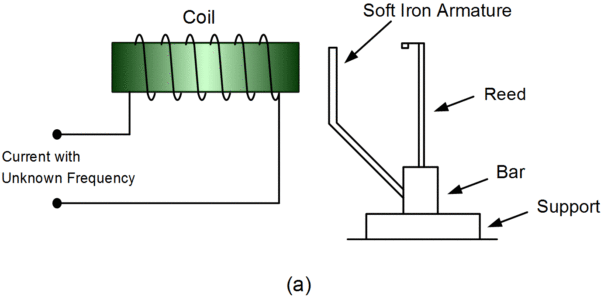The article explores various methods for measuring frequency, including digital frequency meters and reed-type frequency meters. These devices enable the measurement of frequencies ranging from low to hundreds of megahertz, with digital frequency meters providing precise digital readouts based on counted cycles within controlled time periods.
Frequency can be measured with a variety of electric and electronic devices. Electronically, frequency can be measured with such devices as digital frequency counters and heterodyne frequency meters. These devices can measure a wide range of frequencies extending to hundreds of megahertz (MHz).
One of the many frequency meters that directly indicates frequency is reed –type meter of the following figure.
Figure 1: (a) Reed-Type Frequency Meter Circuit Diagram
Figure 1. (b) Indicator Dial of Reed-Type Frequency Meter
In this type of meter, many reeds are mounted on a common support, with their free ends visible on the meter face. Each reed has its own natural frequency of vibration. When an internal electromagnet is excited by a current of unknown frequency, an alternating magnetic field is produced. If the frequency of the field corresponds to the vibration frequency of the reed, that particular reeds vibrate with considerable amplitude. If two adjacent reeds vibrate with the same amplitude, the unknown frequency is halfway between those indicated by the two vibrating reeds. The reed–type meter is useful only at low frequencies and only over a limited range of frequencies.
Another type of frequency meter is the digital frequency meter, which measures frequency up to about 100 MHZ and displays a digital readout of the measured frequency, as shown in Figure 2.
Figure 2. Digital Frequency Meter Block Diagram
A digital frequency meter measures an unknown frequency by counting the number of cycles the frequency produces in a precisely controlled period of time. The counter circuit is incremented one count for each cycle. At the end of the time period, the final count, which represents the frequency, is displayed by the digital readout. For the next sampling of the unknown frequency, the counter is cleared, the time period is started over, and the final count in the counter is again displayed. If the measured frequency is stable, the readout does not change from sample to sample. Because the range switch selects the time period and places the decimal point in the readout, the indicated frequency is in the units specified by the range switch.
When the time period is 1 ms, the readout is in kilohertz, and the range switch indicates kilohertz. For example, if the count at the end of the 1-ms period is 100, the unknown (measured) frequency must be 100 kHz because 100 counts per millisecond is equal to 100,000 counts per second.
Key Takeaways
The ability to accurately measure frequency enables the evaluation and analysis of electrical signals, aiding in the design, testing, and maintenance of electronic systems. Devices such as digital frequency meters and reed-type frequency meters offer practical solutions for frequency measurement, allowing engineers to ensure the proper functioning of circuits, troubleshoot issues, and optimize performance.
Review Questions about Digital Frequency Meters
True or false. Digital frequency meters are limited to measuring power and audio frequencies.
F
True or false. The digital frequency meter counts the cycles produced by the unknown frequency during a precisely controlled period of time.
T
True or false. A vibrating-reed meter usually covers the entire power and audio-frequency range.
F


